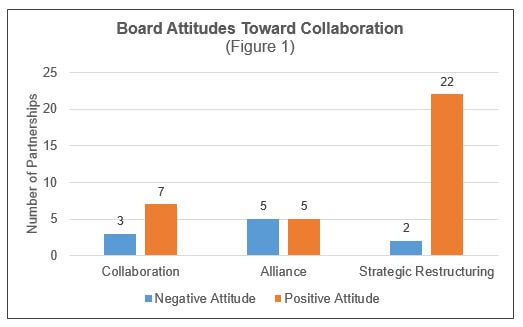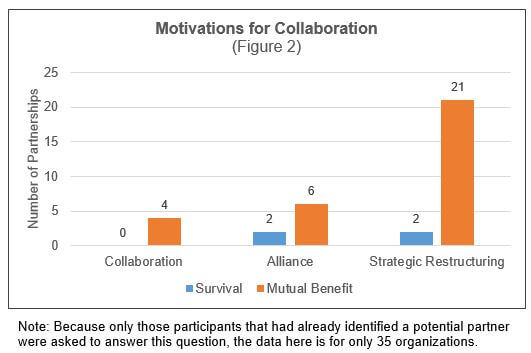New Data on Success Factors in Nonprofit Collaboration
Analysis of pre- and post-partnership data from more than 130 nonprofits shows that factors like board attitudes, strategic aims, and past experiences correlate with the successful negotiation of collaboration, alliance, and strategic restructuring agreements.
Nonprofit and funder interest in collaborative strategies for mission impact continues to grow, as does the increasingly diverse range of ways that organizations are putting partnership into practice. Today, we count at least 15 forms of collaboration, alliance, and strategic restructuring through which nonprofits are doing more by working together. Nevertheless collaboration is not easy, and organizations continue to need support in assessing their many options and preparing for success.
La Piana Consulting developed the Strategic Restructuring Self-Assessment Tool (SRAT) in 2012 to help nonprofits learn about various forms of partnership, clarify what they want from — and can bring to — a collaboration, and examine their readiness to engage in negotiations. We have since used the SRAT with 134 organizations as part of foundation-led strategic restructuring initiatives and other similar efforts to inform and educate about how nonprofit partnerships can lead to greater social impact. This included organizations of all sizes, in locations across the country, and working in a variety of different fields.
Designed as an automated survey and report, the SRAT helps organizations conduct their own assessment and supports internal conversations among board and staff about where goals and expectations for a potential partnership are aligned and where there may be differences. After submitting its answers online, the organization receives a customized report with recommended resources and next steps.
Currently available to funders and federated nonprofits who want to provide it to their grantees or use it within their networks, the SRAT is administered with consultant support to provide critical context, help organizations understand the concepts and language used in the assessment, and prepare them to make the most of the resulting recommendations.
The SRAT has proven effective as a readiness tool for individual organizations, but also offers a valuable data set for analysis. We recently paired SRAT results with follow-up research on the types of partnership that respondents ultimately pursued to determine whether the pre- and post-partnership data offered new insights.
Our analysis of SRAT findings from 44 organizations that went on to negotiate a formal partnership shortly after using the tool confirms and gives texture to much of what we know anecdotally about success factors leading to meaningful collaboration. In the three examples below, we observe how board attitudes, strategic aims, and past experience correlate with the kinds of partnerships that respondents chose, whether a collaboration, alliance, or strategic restructuring.
Board Attitudes
Board beliefs and attitudes about collaboration set the overall tone for partnership exploration, and can either advance or prove a barrier to collaborative strategies. The SRAT asks organizations to characterize their boards’ comfort level with entering into partnership discussions, with multiple choice options including: “generally negative,” “not sure or mixed,” “somewhat comfortable,” and “very comfortable.”
As shown in Figure 1 below, we see a correlation between those organizations reporting positive board attitudes about partnership (indicated by the orange bars) and their successful negotiation of a collaboration or strategic restructuring agreement.

Aims and Motivations
Partnerships are often best approached from a position of strength, or at least from an asset-based perspective. One SRAT question asks respondents to characterize the kind of benefit sought or anticipated from a partnership. Multiple choice selections include: “saving” one of the partner organizations in crisis, benefiting each partner but with a slight advantage to one, and equal benefit to each partner.
As illustrated in Figure 2 below, results indicate that more partnerships resulted among those pursuing some level of mutual benefit (shown in the orange bars) than those citing the mere survival of either partner as their motivation (blue bars).

Past Experience
Sometimes, informal collaboration can lead to more integrated forms of partnership in the future as organizations build trust and rapport with one another and/or experience the value of collaborative strategies in advancing their goals. SRAT participants are asked to characterize their organization’s level of past experience with formal partnerships, ranging from no experience, to limited experience, to significant experience.
As shown in Figure 3 below, results show a significant correlation between past experience (illustrated by the orange and gray bars) and the successful negotiation of a new partnership.

Although the success of a partnership is dependent on many more variables than those few described above, these SRAT findings serve to emphasize some of the conditions under which collaborations tend to flourish. Our hope is that the more data we develop and share, the more fully we will understand, both quantitatively and anecdotally, what leads to and sustains quality nonprofit collaboration.
Read more about the SRAT and how it works here.
Our thanks to Pam Truitt of the Patterson Foundation, who provided valuable feedback on a draft version of this article.


Comment section